1lumen selects and reviews products personally. We may earn affiliate commissions through our links, which help support our testing.
Zebralight SC53c N review
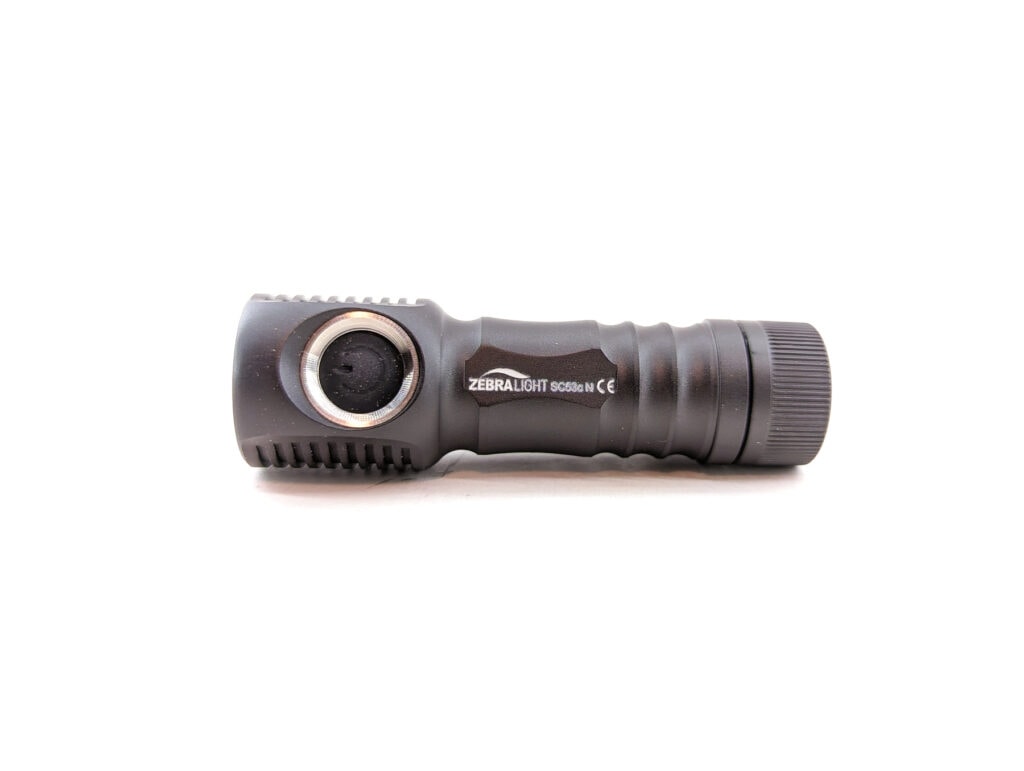
Zebralight SC53c N specs
| Brand & Model | Zebralight SC53c N |
|---|---|
| Flashlight category | EDC flashlight |
| LED | Nichia 519A-V1 |
| Max. output | N/A lumens |
| Max. beam distance | N/A meters |
| Max. beam intensity | N/A cd |
| Battery config. | 1x AA |
| Onboard charging | No |
| Main modes | 3 |
| Blinkies | Beacon Low, Beacon High, Slow Strobe, Fast Strobe |
| Waterproof | IPX8 |
| Review publication date | June 2023 |
Review intro:
Zebralight is a Texas (USA) based manufacturer of premium flashlights. Despite being a USA company, the lights are actually produced in China, as most flashlights are. They’re a unique company with an almost cult-like following. It seems that people that like their Zebralights love their Zebralights and wouldn’t trade them for anything. But somehow up until this review, I’ve never owned one. And now I see what all the fuss is about. They’re tough, well thought out, attractive, very functional, and have a UI that is somehow both extremely easy and extremely flexible.
Zebralight names their lights with seemingly cryptic letters and numbers, but there is a method to the madness. They start off with an SC (side clicky) or H (headlamp), followed by some numbers. The first number indicates battery size: 3 = CR123, 5 = AA (a 14500-size battery), 6 = 18650, and 7 = 21700. And then there’s more letters to indicate things like spot vs floody, LED CCT or color, etc. So when looking at the SC53c N model number, you can immediately tell that we’re talking about a side-clicky AA flashlight (once you’ve been privy to the code, that is). Still confused? Well, Zebralight maintains a big Google Sheet with all of the models (current and discontinued) to help guide you; it’s very handy.
To get started with the Zebralight (“ZL”) SC53c N, just take it out of the box and insert your battery.
Package quality.
The ZL SC53c N arrived in a very plain-looking cardboard box with a simple label stating the brand and model, along with a barcode. While I don’t mind seeing nice fancy boxes, they don’t really sway my impression of the flashlight inside much. After all, I imagine most of us just empty the box out and set it aside, never to be considered again. Inside that box was:
- Zebralight SC53c N
- Spare o-rings
- Operator’s manual
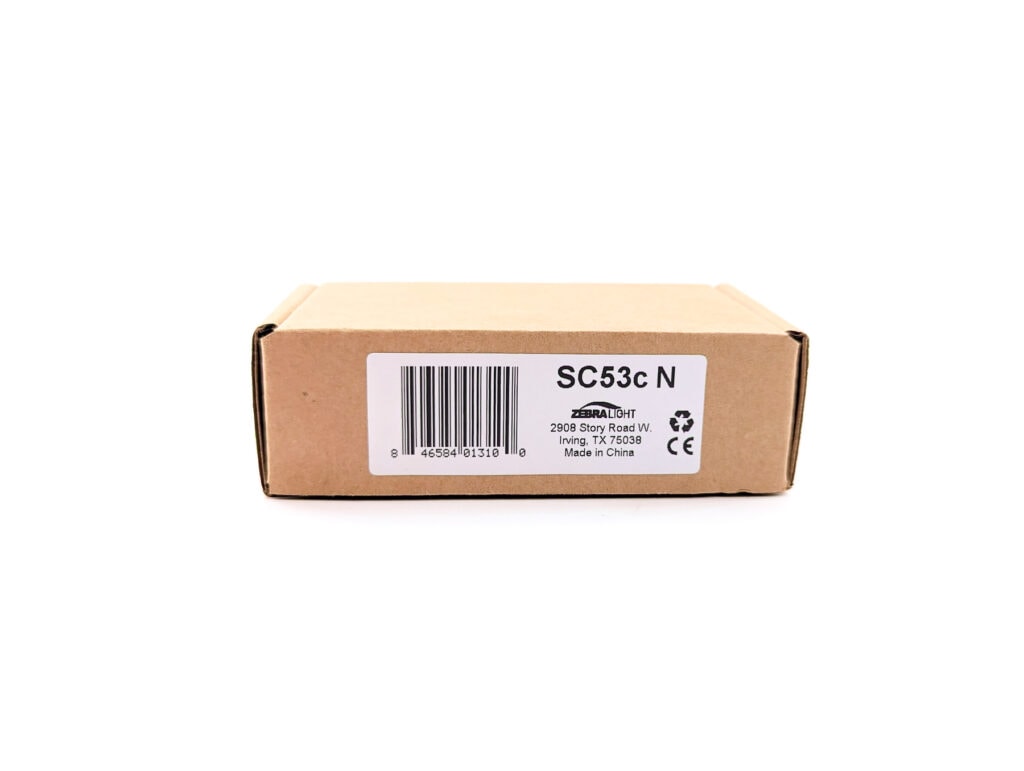
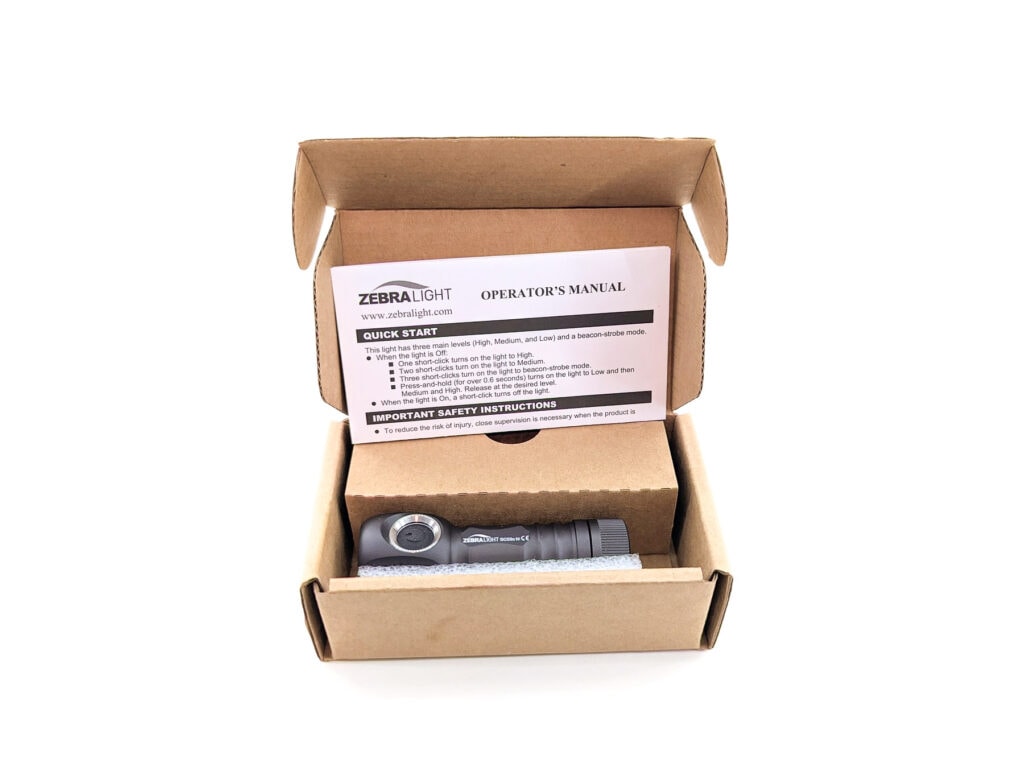
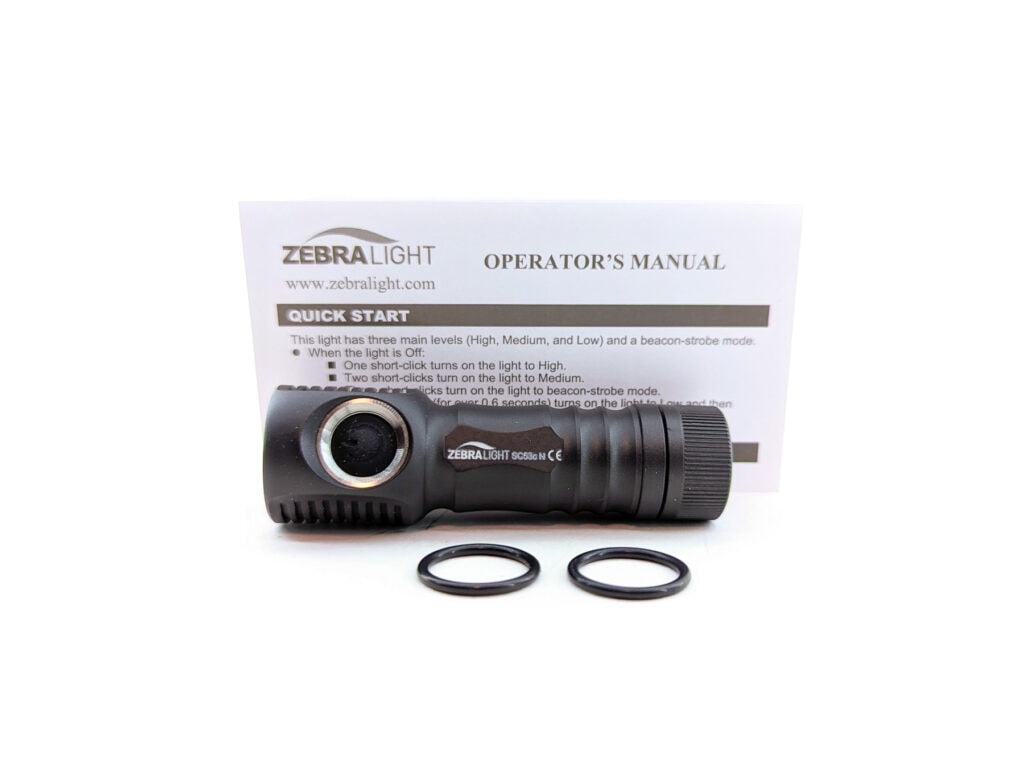
Flashlight in use
The Zebralight SC53c N is a AA-powered flashlight, and as you’d expect, that means this light is quite small and disappears into your hand. There’s no knurling to add grip, but there are a few rings machined into the battery tube that help add some traction, along with the many heatsink fins cut into the head of the light.
This ZL doesn’t have a lanyard provided, or even an obvious place to put one unless you attach it to the pocket clip. The generously-sized clip that is affixed to the end of the battery tube with screws. So it is held on tightly, but can be removed or replaced if it’s not your cup of tea. The clip is very functional, but is definitely not deep-carry: you’d end up with ⅝” (16mm) sticking out of your pocket. Those people that are particularly particular about their pocket clips might replace it with an aftermarket one; many clips designed for Spyderco knives will swap in – just make sure the bends sit where they need to.
One of the many aspects of Zebralights that people tend to love is the switch, and I have to agree with them. The e-switch is located on a bump out on the head of the light. The switch is fairly large and easy to activate. It’s a very short and responsive click. The switch is recessed a bit deep, and makes accidental activation nearly impossible. I carried the SC53c N in my pocket for many days and it never once turned on by accident. It’s nice, not having to worry about locking the light out or doing weird things with the UI just to avoid having the light turn on in your pocket.
If you’re curious about how this switch feels in person, imagine Hank’s (flashlight designer of Emisar and Noctigon flashlights) raised retaining ring on a flashlight, but with the body designed so that the top of the ring sits flush with the aluminum. It really is nice to use.
So just what would I use the ZL SC53c N for? Well, it’s good to keep expectations in check here. If you’re used to high-powered 1,000+ lumen lights, you need to remember that this one is powered by a single AA battery and so its output is much less. But what you gain is quality of light and a convenient “take me everywhere” size. In the couple of weeks that the ZL rode in my pocket, it saw a lot of use around my workplace and home. I also used it on walks around the neighborhood, scrounging around in the garage, etc. It’s a great all-around EDC flashlight as long as you don’t need a ton of raw lumens.
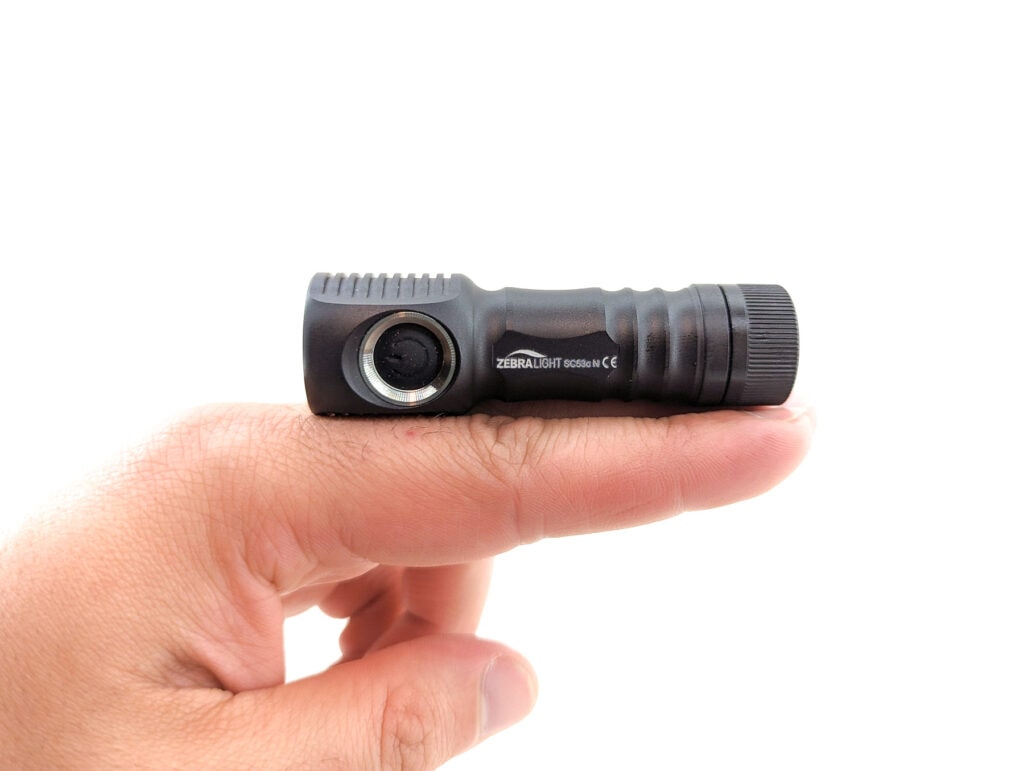
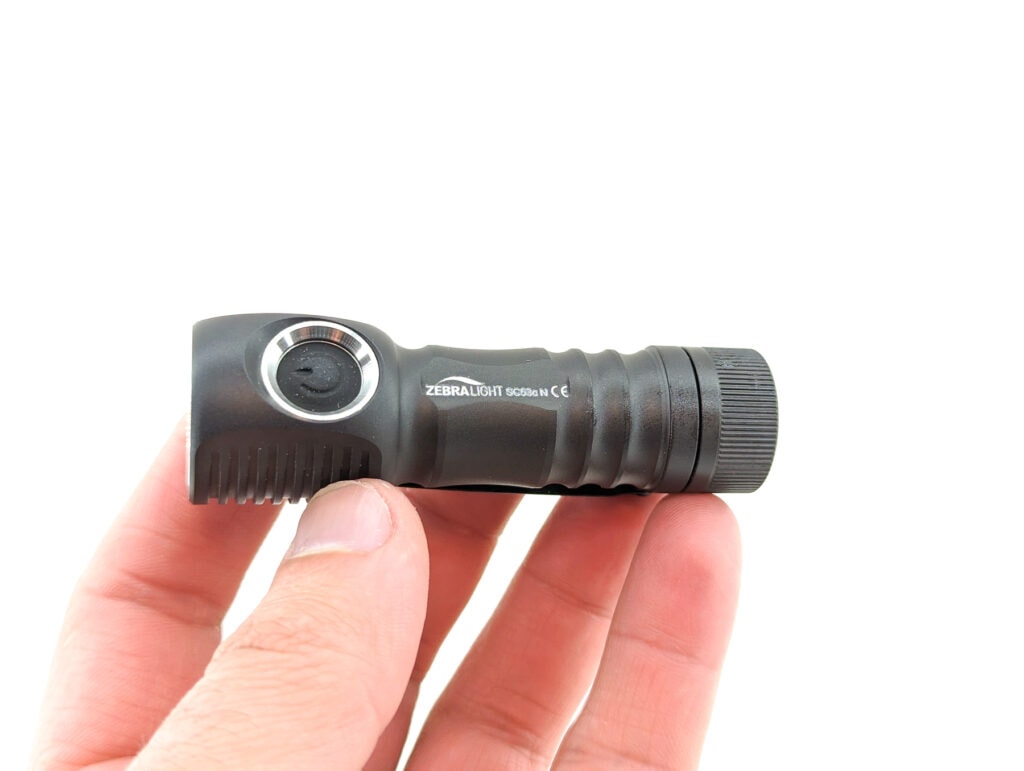
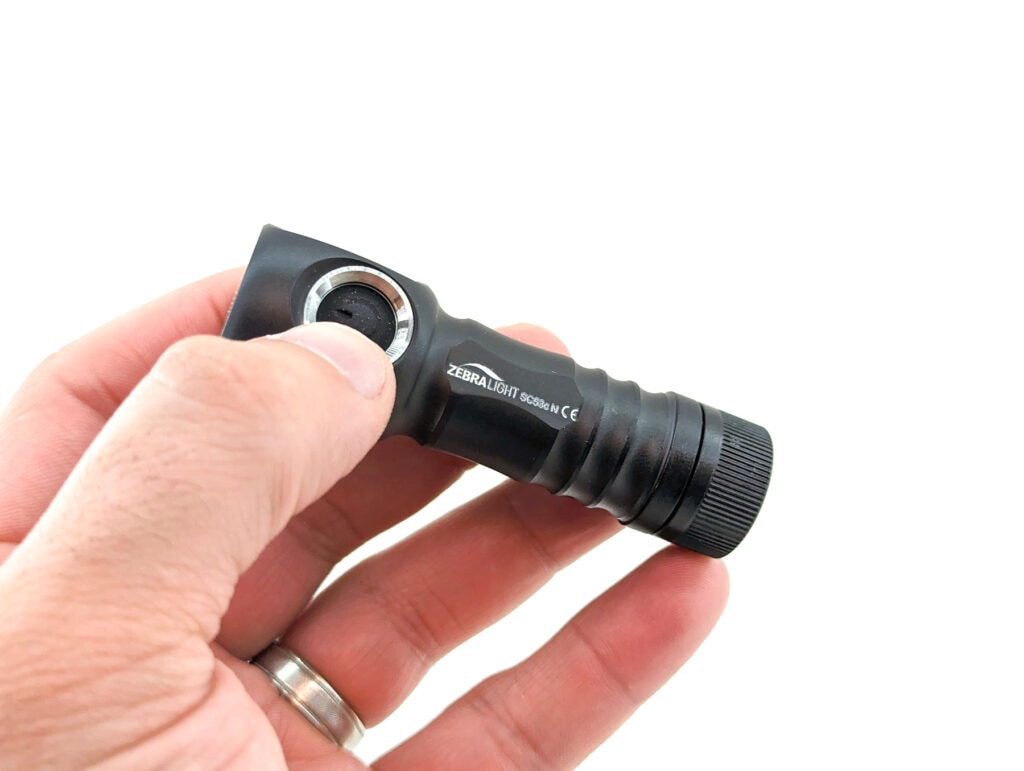
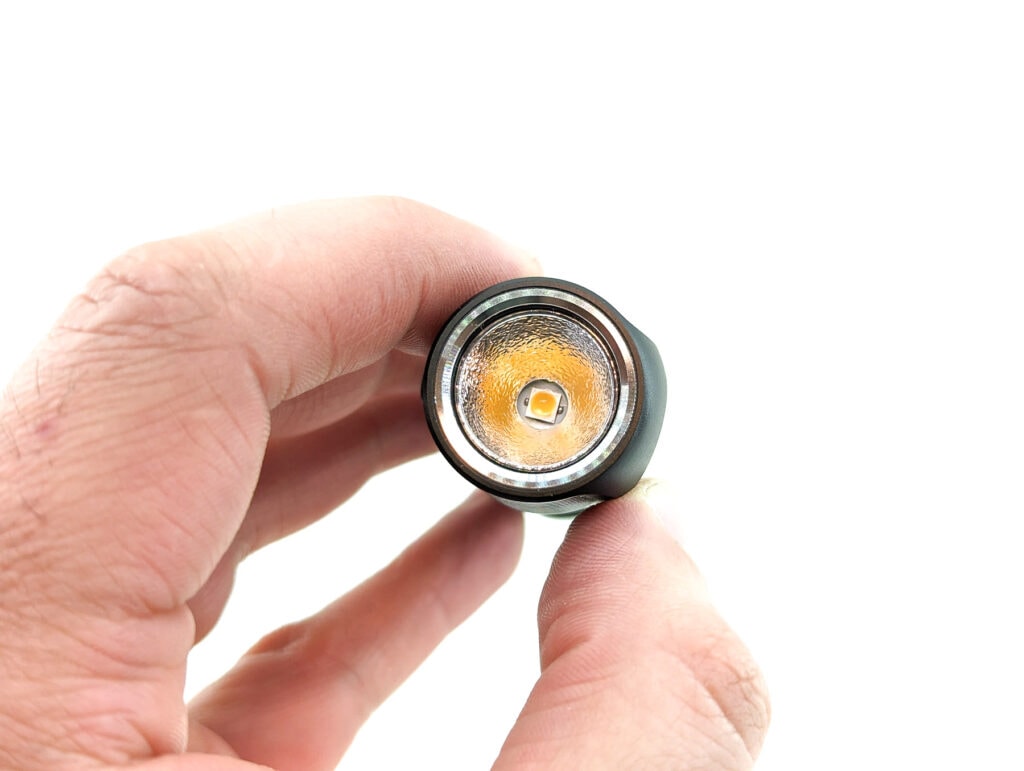
Build Quality and Warranty
When it comes to build quality, Zebralight doesn’t horse around. The flashlight features a unibody design, cut from “premium grade” aluminum bar stock. They’ve finished off the aluminum with Type III Class I hard anodizing. The coating seems to be more of a dark grey than black. It’s smooth, satiny, and feels great in the hand.
ZL boasts of a “proprietary heat sinking design [that] bonds the LED board directly to the unibody aluminum casing.” While I haven’t taken a Zebralight apart, I’ve seen enough teardowns to know that ZL combines the LED and all of the driver components on a single MCPCB and screws that down tight to the unibody, and then covers the components in potting which helps against things like impacts. All of that keeps the electronics very compact and very tough.
Warranty:
- 30 day complete satisfaction guarantee
- 12 month repair or replace coverage
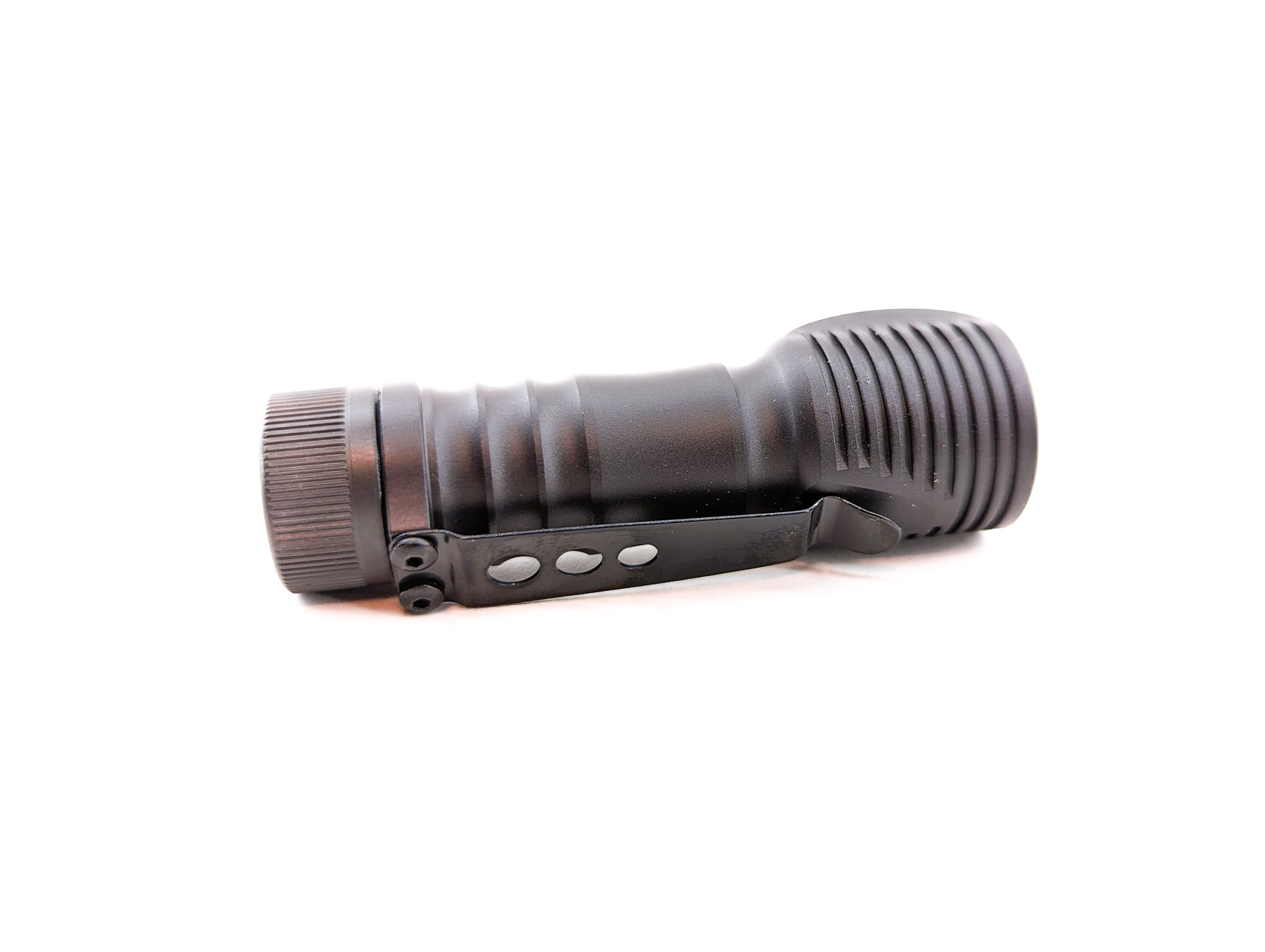


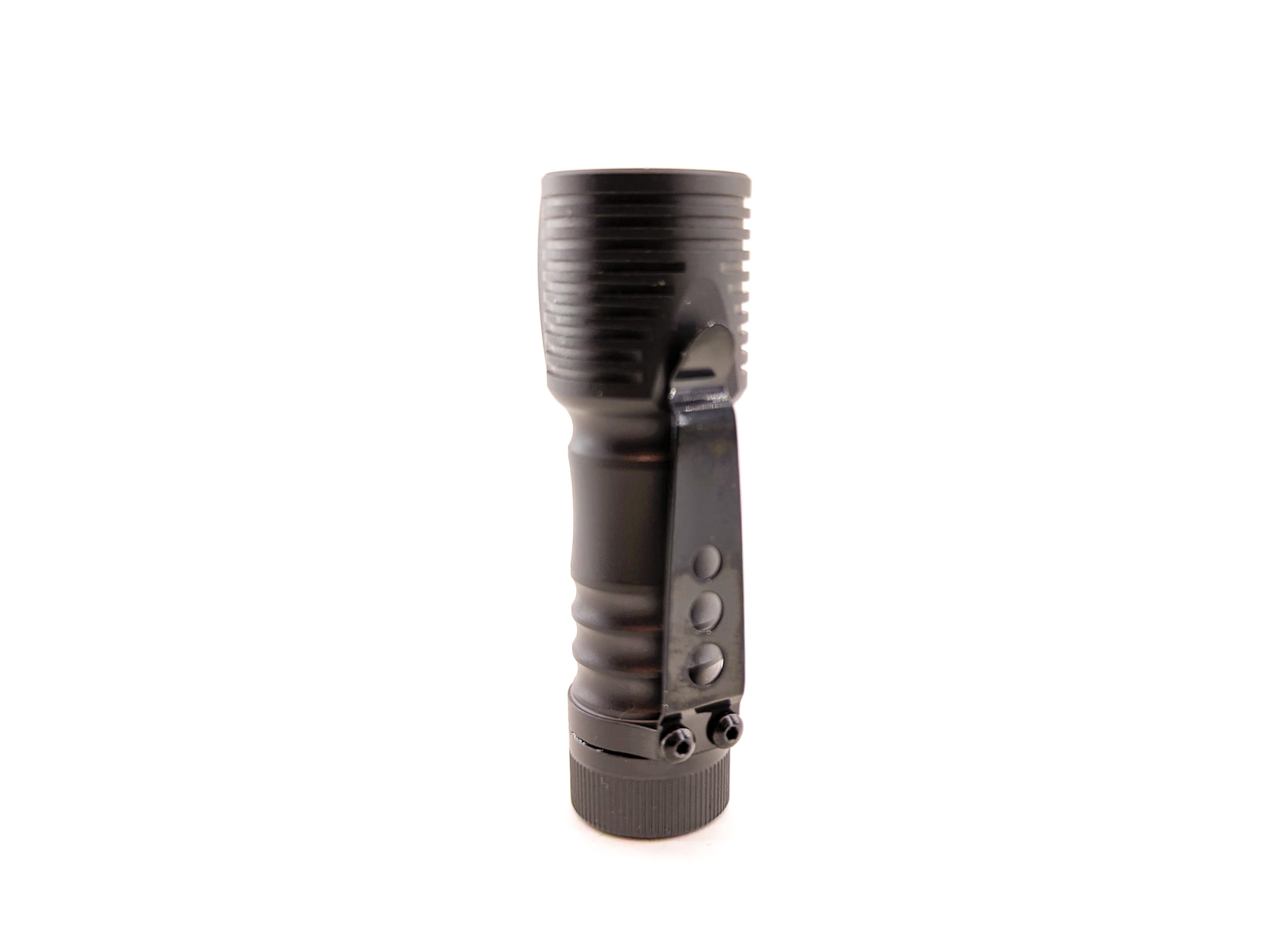
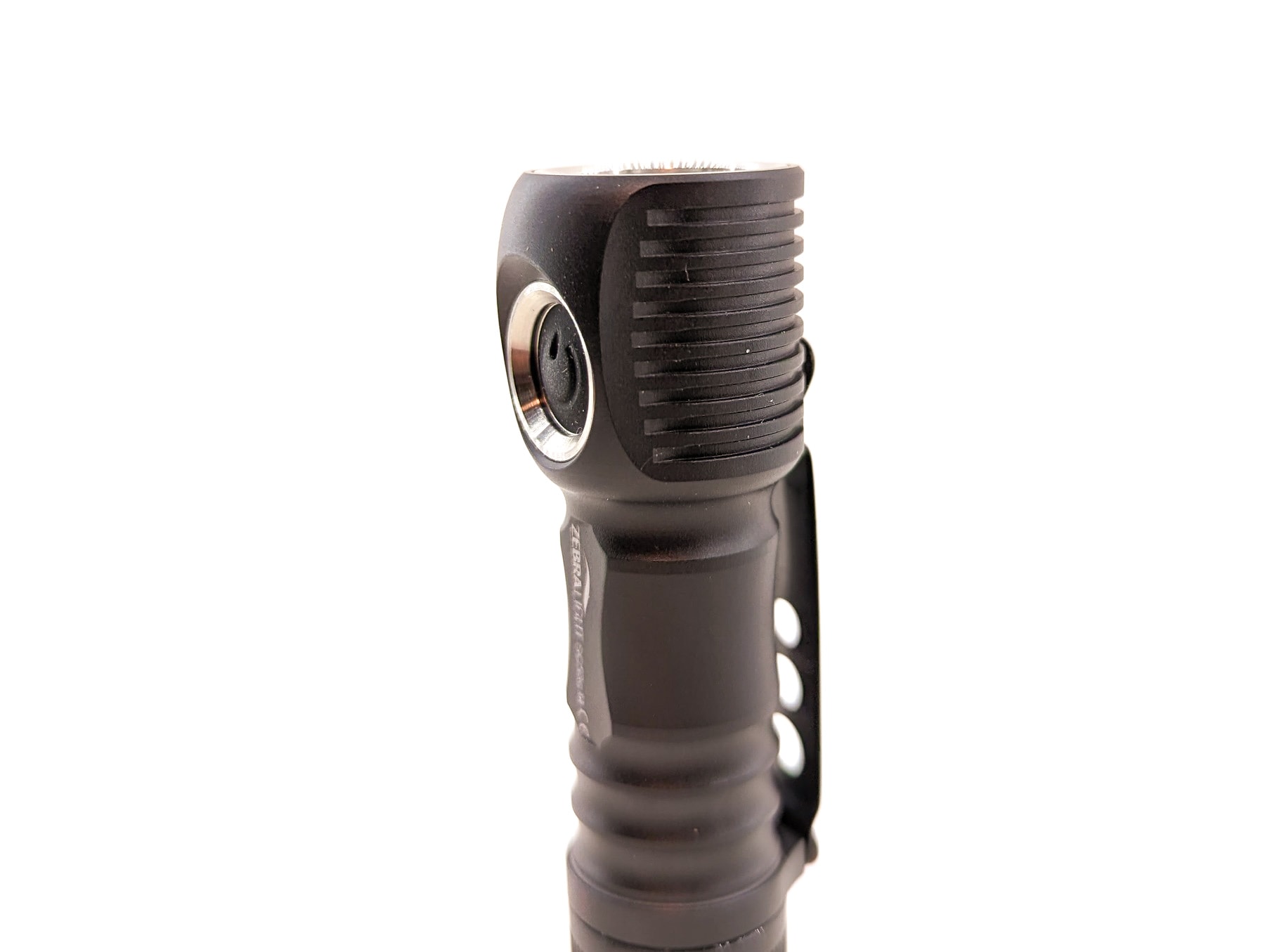
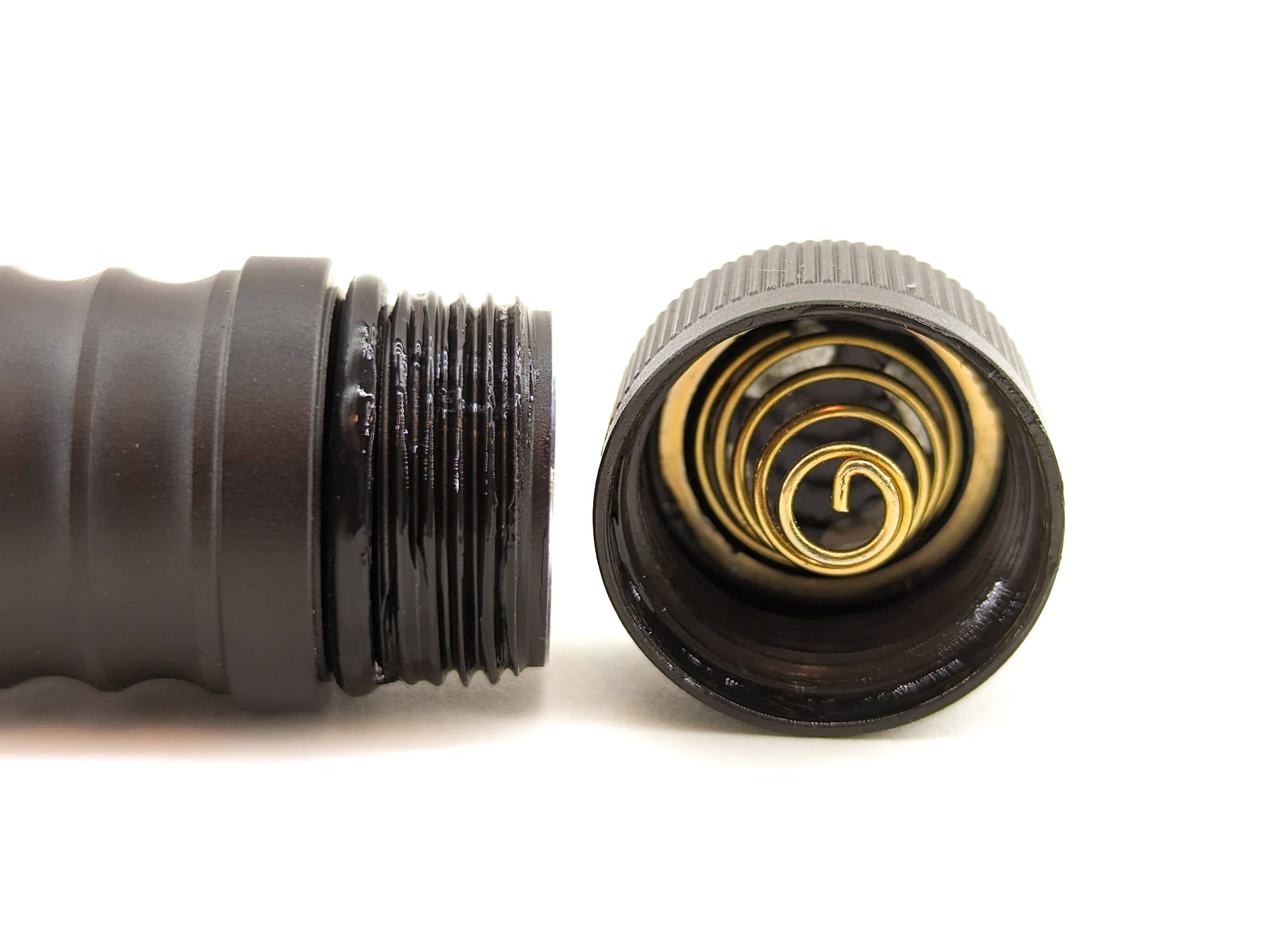
LED, Lens, Bezel, Beam, and Reflector
Zebralight uses a wide variety of LEDs and brands across their product line. One of the highlights of the SC53c N is the emitter they chose: the Nichia 519A. But it’s not just any 519. This is a 519A-V1 (update of the 519A) with a CCT of 4000K, a “typical CRI” of 93, and a 3-step tint deviation. If you’re not familiar with tint deviation, it’s essentially a guarantee of the tint being very close to the Black Body Line (BBL). Many LEDs we see are a 5-step deviation, which open up the possibility for less-than-optimal tints.
The high-quality Nichia LED is nicely centered in a light orange peel reflector. ZL covered the reflector in a sheet of Corning Gorilla Glass, and then topped it off with a beautiful smooth stainless steel bezel. The resulting beam is clean and warm, with a smooth transition from the hotspot to the spill.
Opple Light Master readings from High (H1) at 2 meters:
- CCT: 3950K
- CRI: 97.2 Ra
- DUV: +0.0014
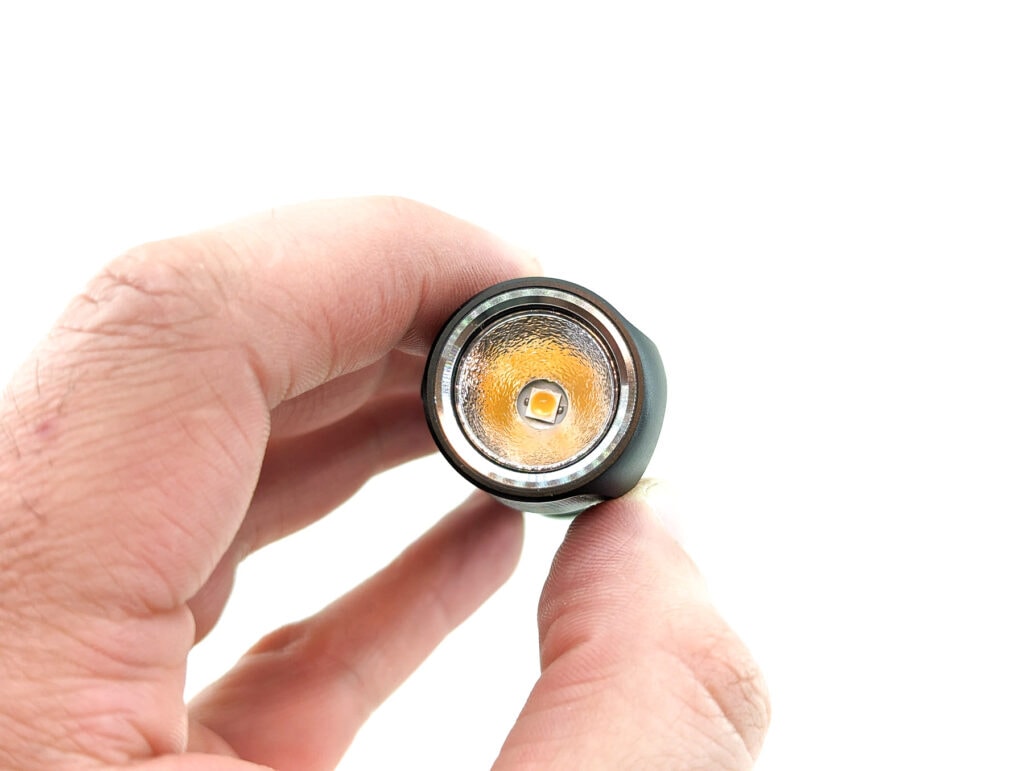
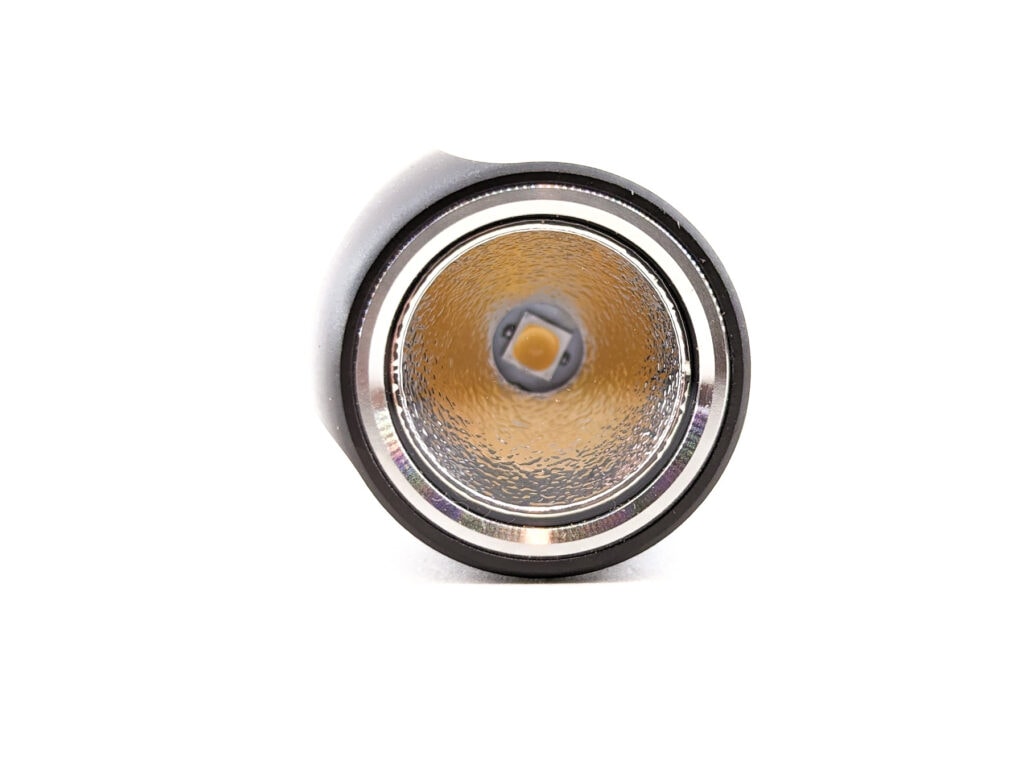
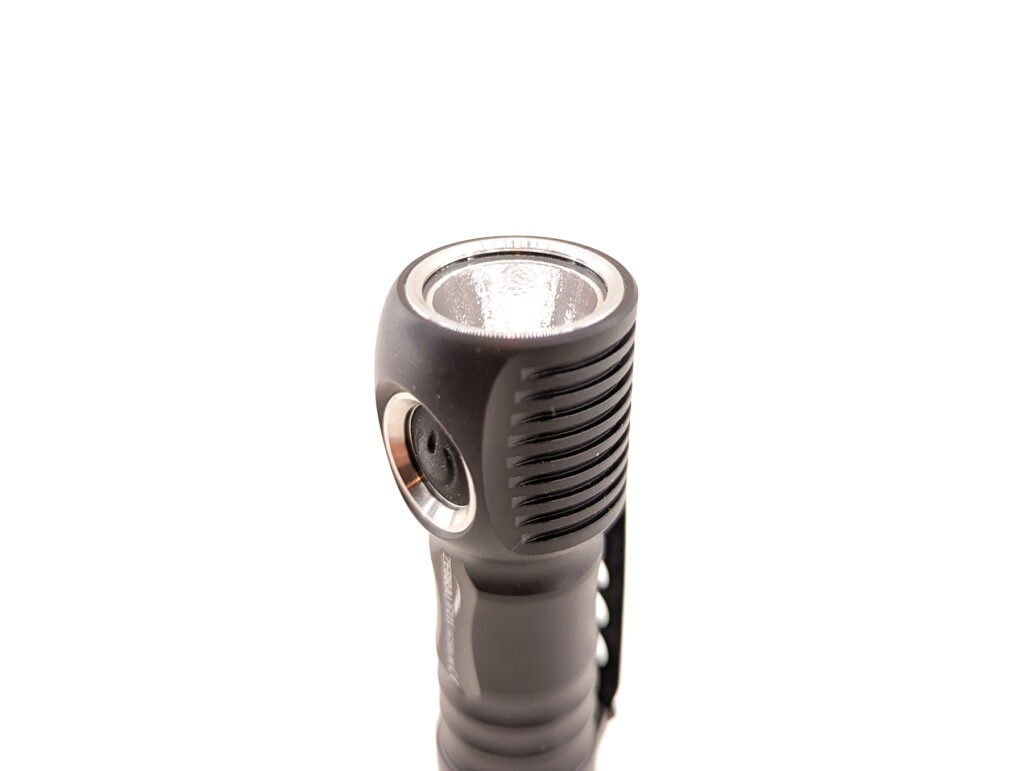
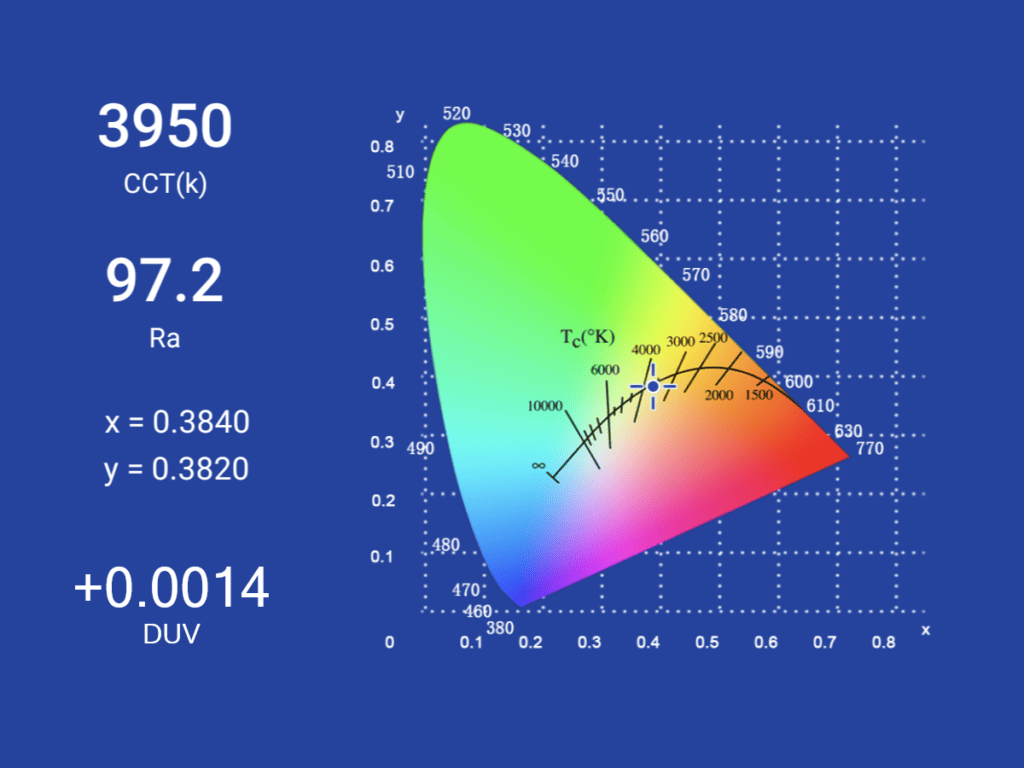
Dimensions and its competition
Dimensions:
| Zebralight SC53c N | Millimeters | Inches |
|---|---|---|
| Length | 78 mm | 3.0 in |
| Head diameter | 24 mm | 0.9 in |
| Body diameter | 21 mm | 0.8 in |
Dimensions are rounded to the nearest millimeter, and to the nearest tenth of an Inch.
Weight:
| Zebralight SC53c N | Weight in grams | Weight in oz |
|---|---|---|
| Without battery: | 39 g | 1.4 oz |
| With battery (Eneloop Pro) | 69 g | 2.4 oz |
Weight is rounded to the nearest gram, and to the nearest tenth of an Oz.
Flashlight size comparison with its competition:
Group 1: Wurkkos TS10, Zebralight SC53c N, Sofirn SP10 Pro
Group 2: Reylight TI LAN, Zebralight SC53c N
Group 3: Fujitsu (Eneloop) Pro AA, Zebralight SC53c N, Molicel P42A 21700
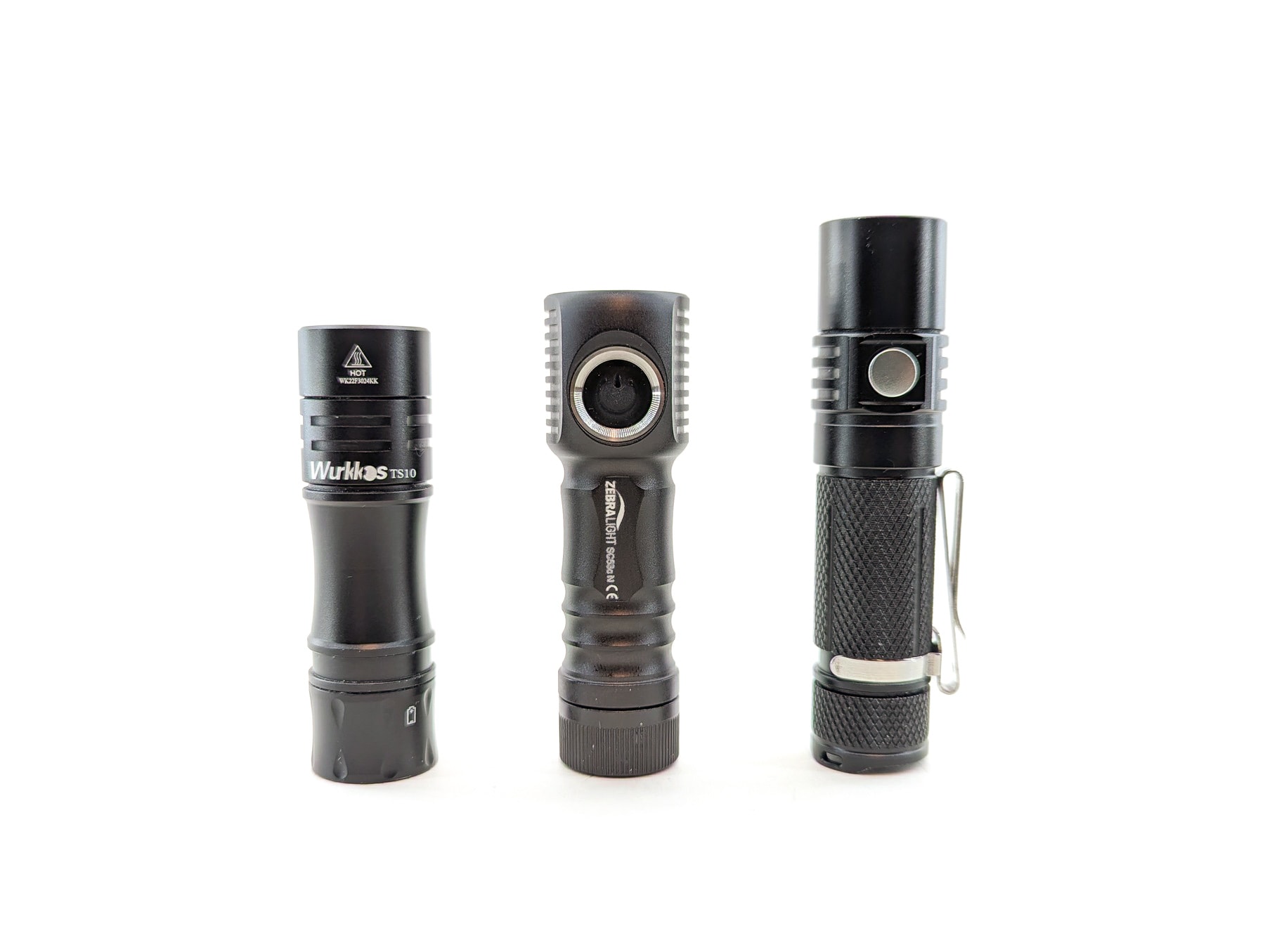
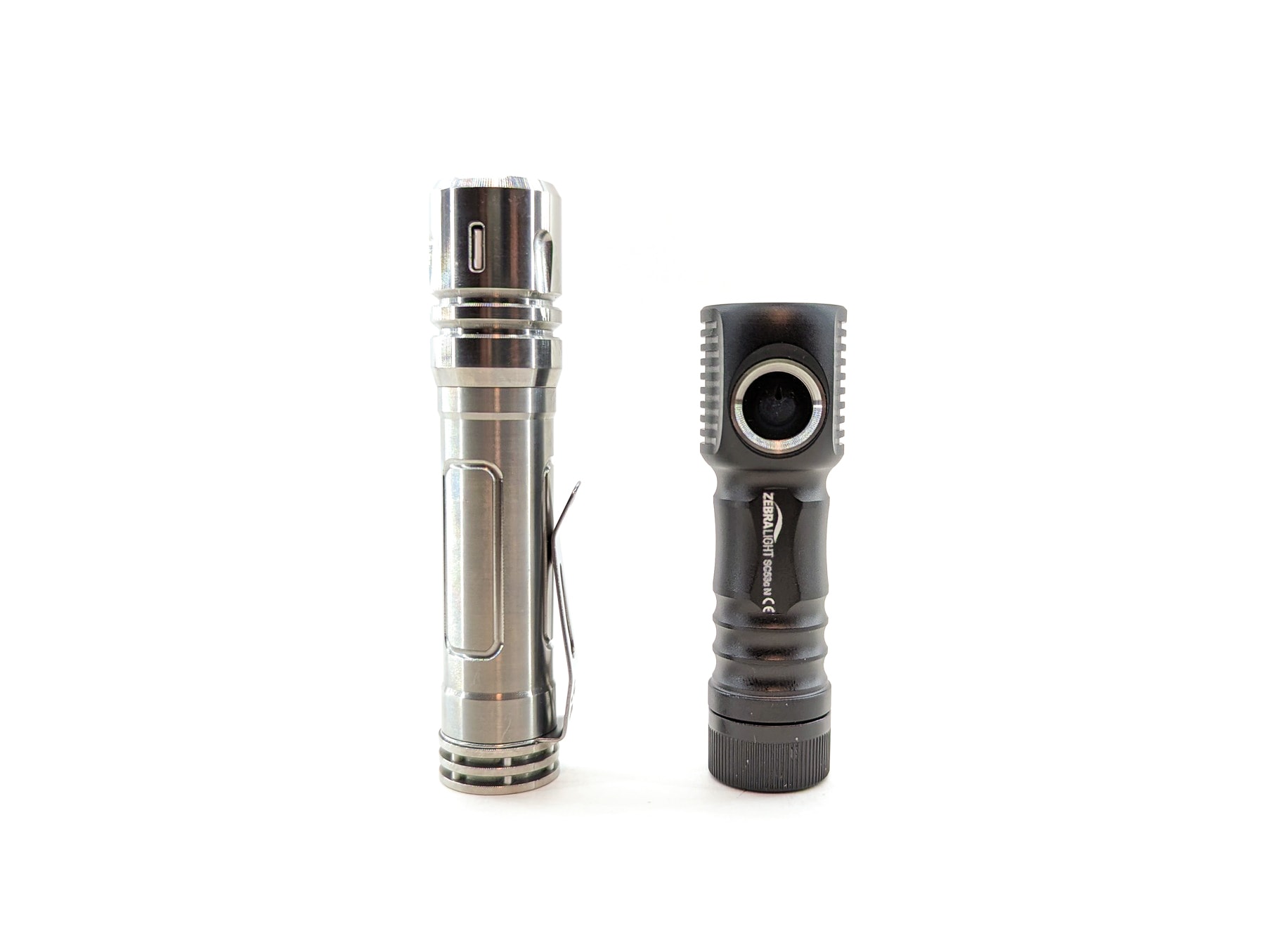
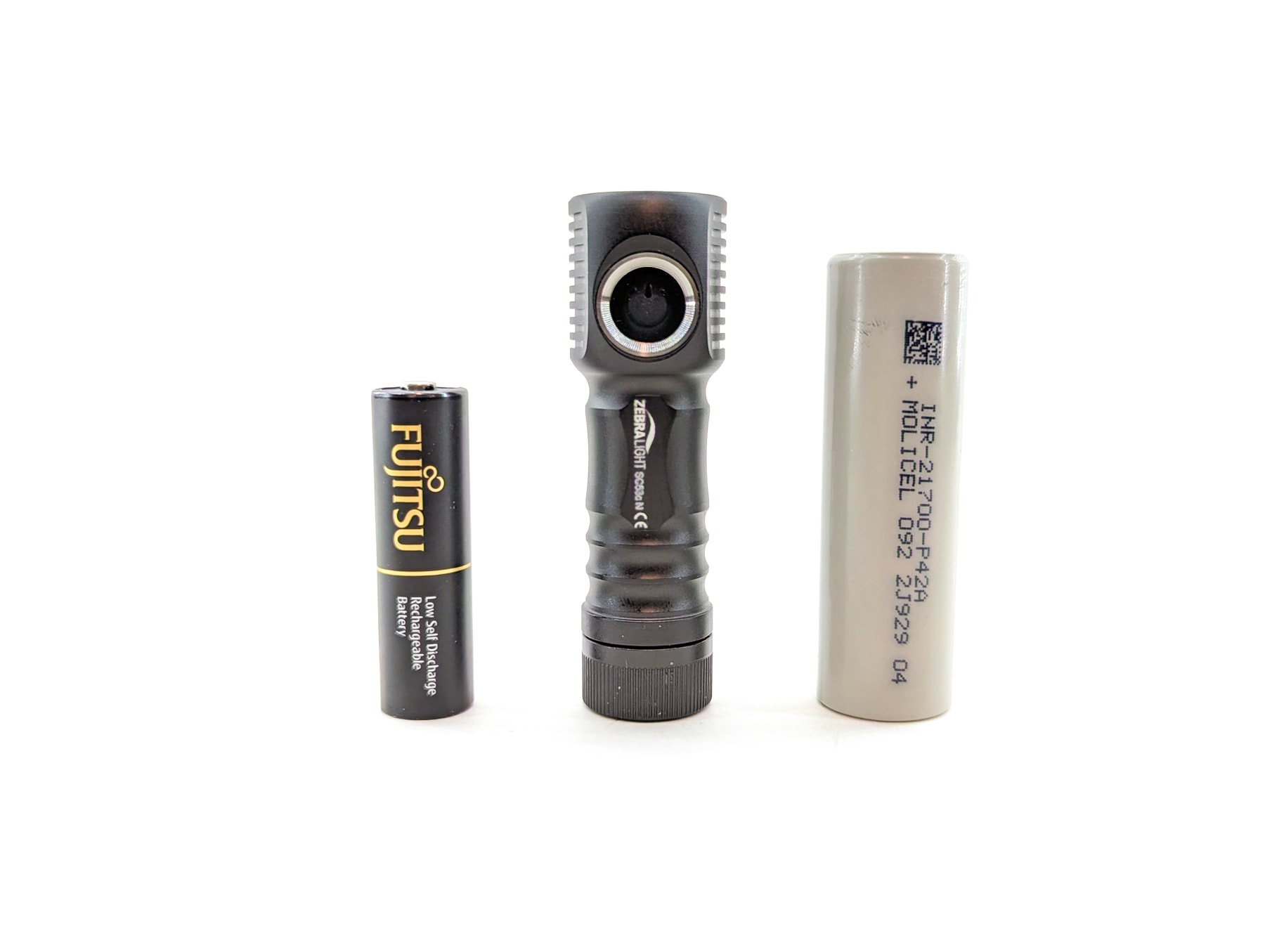
Zebralight SC53c N UI: User Interface and Driver
Available modes:
- 3 main levels, each with a sub-level, 12 available levels total
Available blinky modes:
- 0.2 Hz Beacon at Low
- 0.2 Hz Beacon at H1 (High)
- 4 Hz Strobe at H1 (High)
- 19 Hz Strobe at H1 (High)
From OFF:
- Press and hold 0.6 seconds: Low mode (and if you keep holding, goes to Medium, and then High)
- Single click: High mode
- Double click: Medium mode
- 3 fast clicks: Beacon-strobe mode
- 4 fast clicks: Battery check (1 to 4 blinks)
From ON:
- Press and hold: change brightness
- 1 click: turn Off
- Double click: toggle between sub-levels
Mode memory:
- There is no memory for normal modes (Low, Medium, High) since each is a direct shortcut from Off
- The sub-levels are memorized; so if you switched to the lower of the low modes, that’s what it will come back on in when you reactivate Low mode
- The beacon-strobe set has memory; so if you exited the beacon-strobe modes in 4 Hz Strobe, that’s what you’ll get the next time you enter beacon-strobe
Shortcuts:
- To Low: press and hold from Off
- To Medium: double click from Off
- To High: single click from Off
- To Beacon-Strobe: triple click from Off
Low voltage warning/protection:
- Output will step down as the battery level drops
- A battery check (1 to 4 blinks) is available with 4 clicks from Off
- Low battery alert (flashing once every 10-20 seconds) when the light is switched OFF
Strobe/blinkies
- Triple click from Off to activate the beacon-strobe mode
- Double click to switch to the next beacon-strobe mode:
- 0.2 Hz Beacon at Low
- 0.2 Hz Beacon at H1 (High)
- 4 Hz Strobe at H1 (High)
- 19 Hz Strobe at H1 (High)
Lock-out mode:
- None
- If you feel the need to lock out the light, you can do a partial turn of the tailcap to physically lock it out
PWM
- None present
Additional/summary info on the UI:
- At first I was intimidated by the description of the UI. But it can be really easy to use. If a person wants to treat it as a click-on, click-off light and never change modes, you essentially have a 100% single-mode light.
- Aside from that, you also have direct access to the other two modes (Low and Medium).
- If you want to get more complicated, each of the three modes has a sub-level you can access that has a slightly different brightness.
Want to get really crazy? There are 3 different mode groups that you can quickly switch between. These are named G5, G6, and G7 because that’s how you switch between them: 5, 6, or 7 clicks from Off. In each of these mode groups, you can reprogram each of the levels and sub-levels with one of the available 12 brightness levels (note: G5 has some restrictions). I could go on and on about programming Zebralights, but if you’re curious to know more, you might check this or this resource, or any of the several others that are available.
Zebralight SC53c N Charging and batteries
The Zebralight, officially speaking, is a single AA-powered flashlight. ZL says that you can use NiMH, lithium primaries (like Energizer Ultimate Lithium), or alkaline batteries. I wouldn’t recommend alkalines because of voltage sag and their propensity for leaking. My go-to (and ZL’s recommendation) is the Panasonic Eneloop (or Eneloop Pro).
I have seen some reports of people trying lithium-ion batteries (3.7V) with their SC53c N flashlights, but it goes against Zebralight’s recommendation and will probably void your warranty. Do so at your own risk.
There is no built-in charging, which is par for the course on AA flashlights. You don’t want to risk an unsuspecting person trying to recharge a non-rechargeable battery.
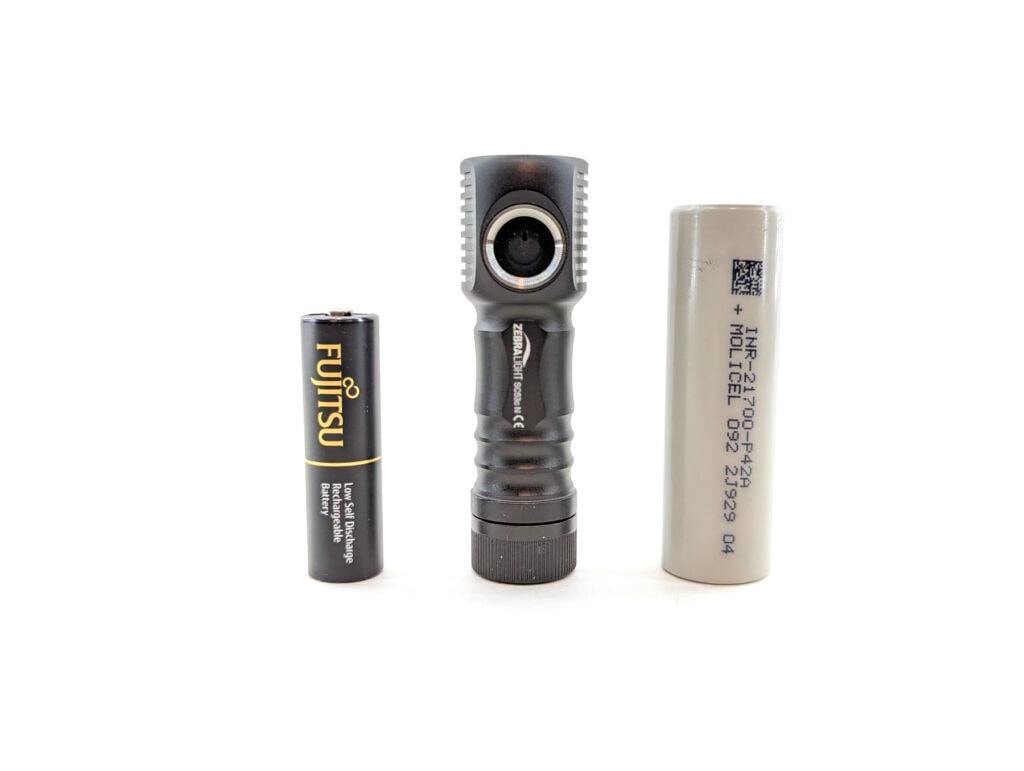
Performance test
Lumen measurements
How Lumens are Measured: Understanding ANSI FL1 Standards How Lumens are Measured: Understanding ANSI FL1 Standards: The ANSI FL1 standards specify that output in lumens should be measured 30 seconds after turning on, as this is the standardized time for measuring brightness according to the industry standard. This is why we focus on this part in our measurements. The ANSI FL1 standards require an ambient temperature of 22 ± 3°C. We record the ambient the ambient temperature to identify potential reasons for any observed discrepancies.Lux was measured by a UNI-T UT383 BT at 2 meters due to the low lumen and candela values. Lumens were measured in a homemade lumen tube using a VEML7700 sensor, calibrated with a calibration light provided by 1Lumen. A Fujitsu (Eneloop) Pro AA was used for testing. The light was left in the original G5 mode group as set up at the factory.
| Mode | Amps at start | Specs | turn on | 30 sec | 10 minutes |
|---|---|---|---|---|---|
| L2 | 6 mA | – | 0.1 lm | 0.1 lm | – |
| L1 | 12 mA | – | 0.8 lm | 0.8 lm | – |
| M2 | 46 mA | – | 7 lm | 7 lm | – |
| M1 | 336 mA | – | 51 lm | 51 lm | 51 lm |
| H2 | 1.0 A | – | 169 lm | 167 lm | 164 lm |
| H1 | 2.4 A | – | 261 lm | 235 lm | 181 lm |
Parasitic drain:
- 3 µA (crazy low!)
The Zebralight SC53c N was released in March 2023. Even as of June 2023 when this review was written, official output and runtime specs were not available. So I’ve shown my test results, but there is currently nothing official to compare it to. Overall, though, I’d say the SC53c N did very well for a single AA light, especially considering it has a warm, high-CRI LED.
Zebralight SC53c N Battery Life: Runtime graphs
How Runtimes are Measured: Understanding ANSI FL1 Standards About ANSI FL1 runtime standards: The runtime is measured until the light drops to 10% of its initial output (30 seconds after turning on). This does not mean that the flashlight is not usable anymore. The last column shows how long the light actually works till it shuts off. If there is a + symbol, it means that the test was stopped at that particular point, but the light was actually still running. This happens on certain occasions, with certain drivers, firmware, or batteries.| Mode | Specified | Measured runtime ANSI | Time till shut off |
|---|---|---|---|
| M1 | – | 6h 7min | 6h 31min+ |
| H2 | – | 1h 23min | 2h 14min+ |
| H1 | – | 1h 22min | 2h 55min+ |
Again, I don’t have anything official to compare this to, but it seems very good for what it is. The light did keep chugging along at just a couple of lumens, so I eventually just stopped the tests.
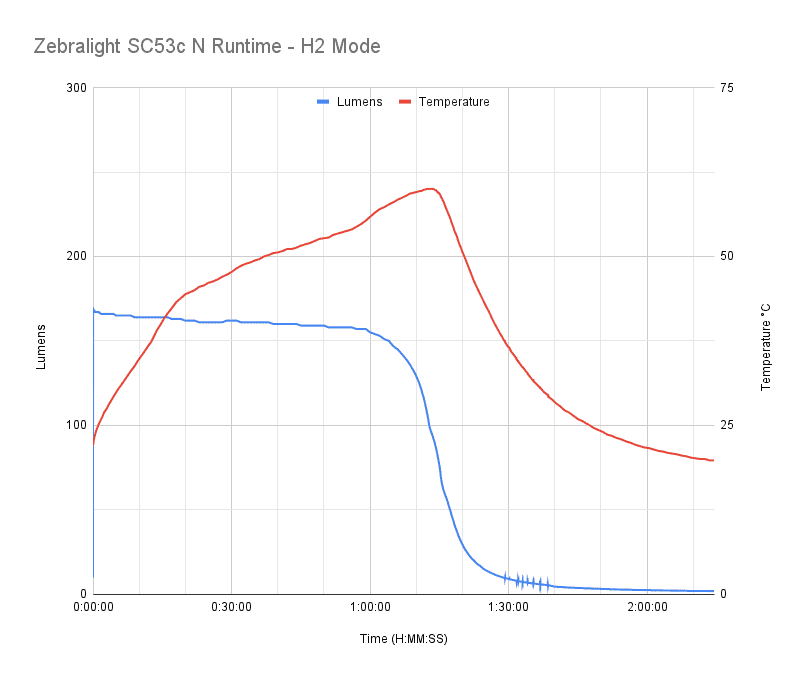
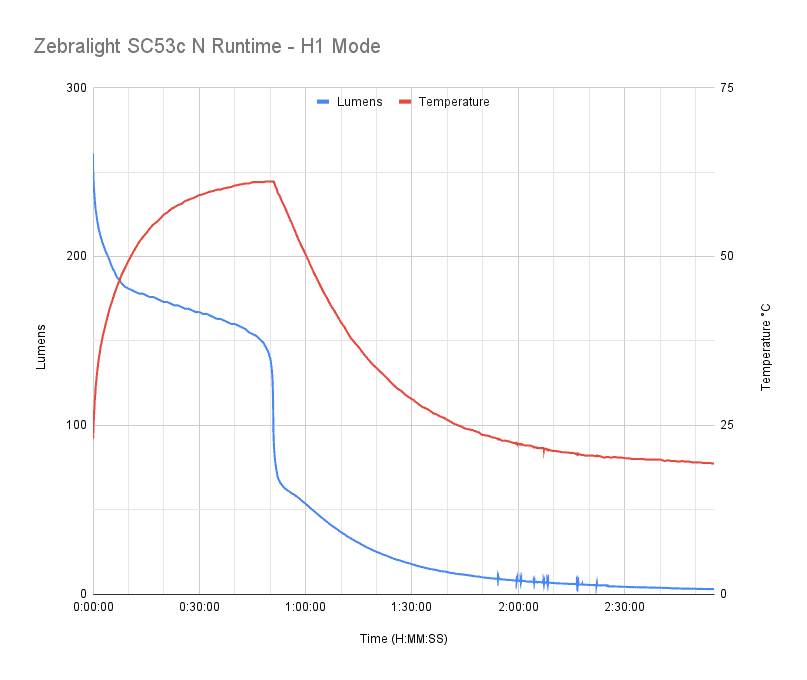
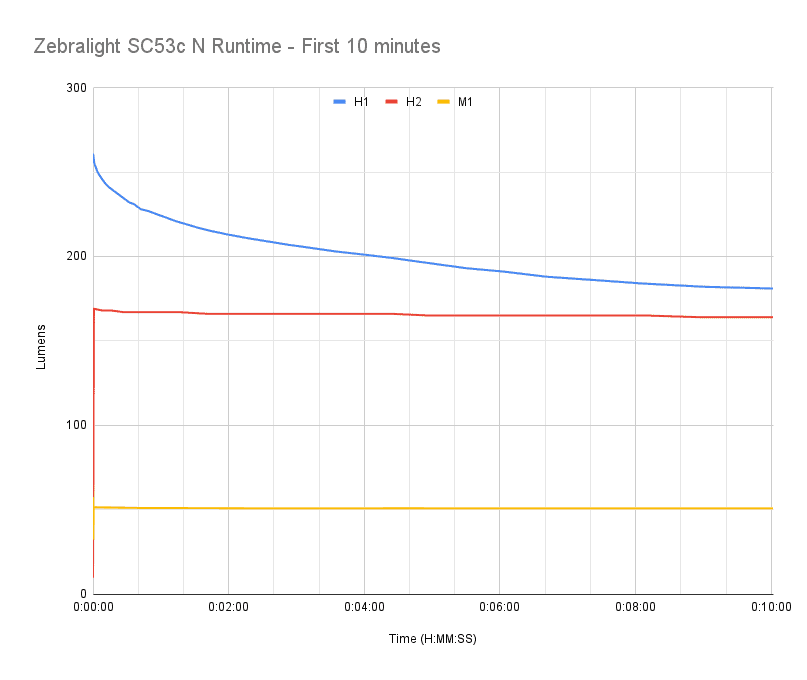
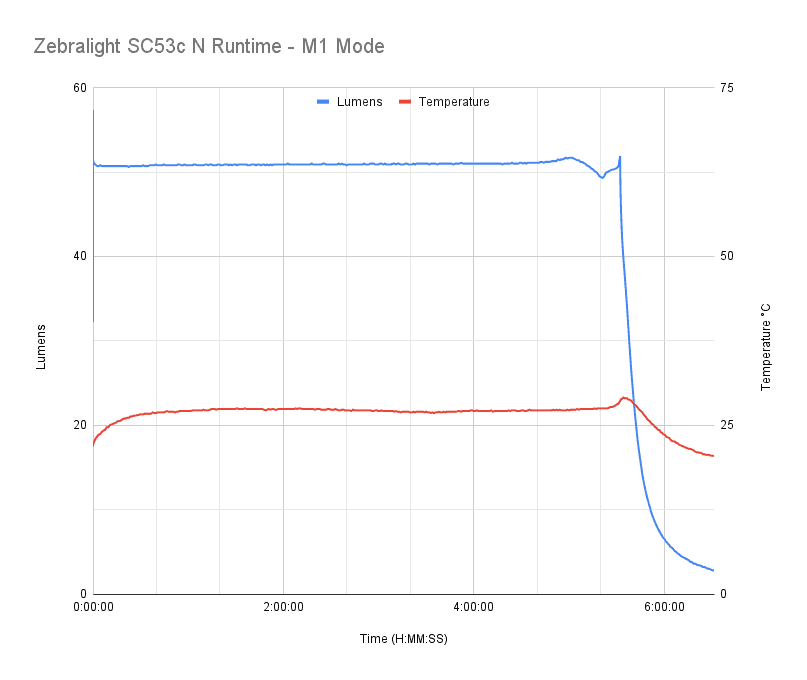
Peak beam intensity and beam distance measurements
About Peak beam intensity: Understanding ANSI FL1 Standards About peak beam intensity The calculated value of distance in meters at which the flashlight produces a light intensity of 0.25 lux. (0.25 lux is about the brightness of a full moon shining on an object). This means that the intensity has decreased so much, it becomes difficult to see darker objects, or objects that don’t reflect light. The columns ‘Meters’ and ‘Yards’ use rounded numbers.Intensity was measured at 2 meters (due to the low intensity) after being turned on for 30 seconds. A UNI-T UT383 BT lux meter was used.
| Mode | Specs | Candela measured | Meters | Yards |
|---|---|---|---|---|
| M2 | – | 44 | 13 m | 15 yd |
| M1 | – | 268 | 33 m | 36 yd |
| H2 | – | 776 | 56 m | 61 yd |
| H1 | – | 1,108 cd | 67 m | 73 yd |
You’re certainly not going to be reaching any distant shores with this light, but that’s not what it is made for. For around the house, reading, walking… a nicely diffused light like this is pleasant to use.
Beamshots
Camera settings and distance:
Beam shots of the building are taken at 5 m (5.5 yd) using a Pixel 7 set to ISO 800 with 1/30 second exposure time
Beamshots of the following flashlights compared:
- Zebralight SC53c N
- NEXTORCH K40
- Rovyvon A8 G3
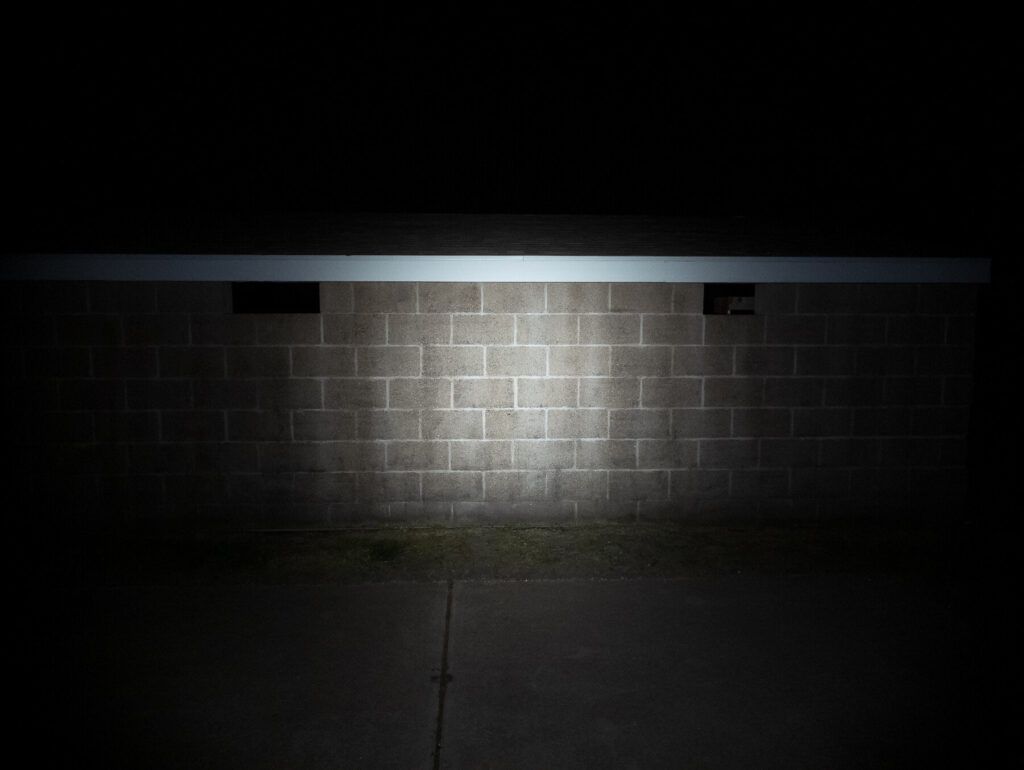
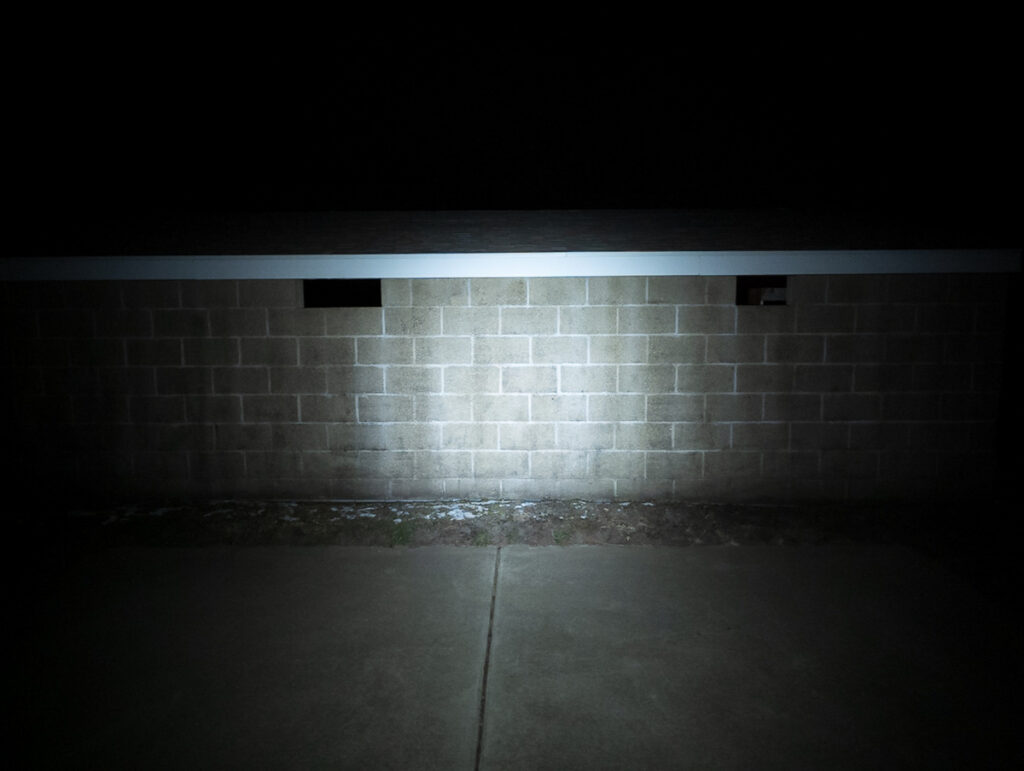
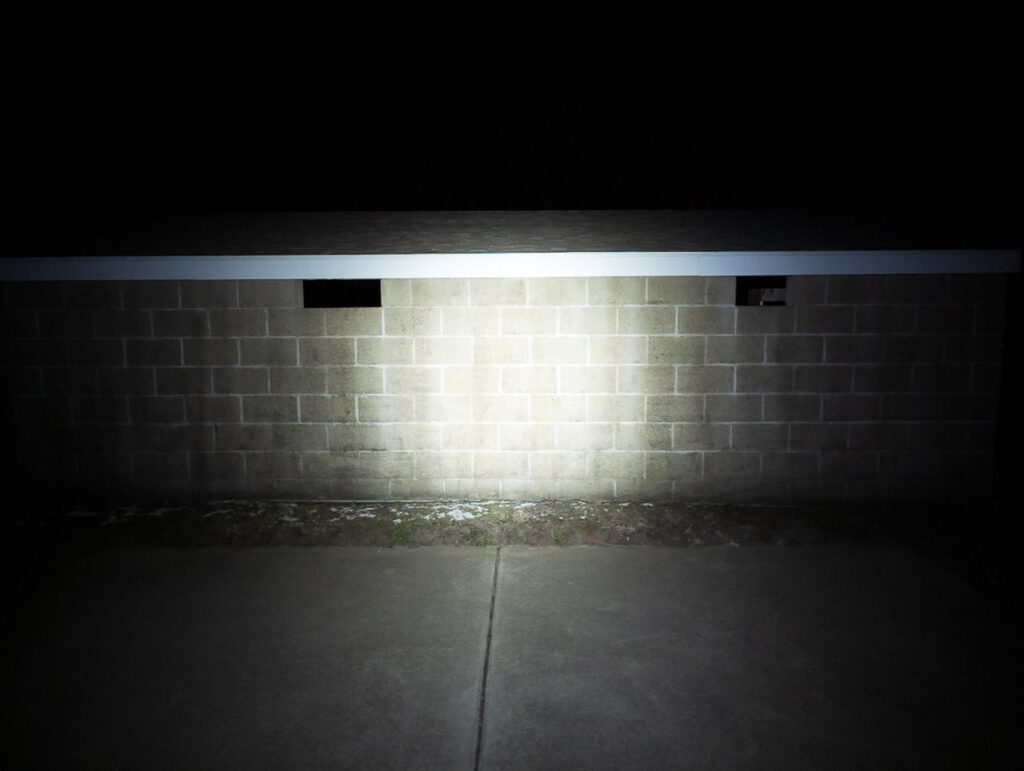
We bought this flashlight with our own money. Nobody paid us to review this flashlight, nor have we been holding back on problems or defects.
Final Verdict
Pros
- Really well built, high quality
- Simple yet highly flexible UI
- Great Nichia 519A-V1 LED
- Compact design
- Excellent button
- Really low moonlight mode
Cons
- No official lithium-ion support (so limited brightness)
- Pocket clip isn’t deep carry
Explanation on star ratings:
1: Avoid: a match would be a better choice – 2: Poor: significant defect or issues; almost unusable – 3: Average: some defects or issues; but still usable 4: Good: recommended (minor issues) – 5: Great: highly recommended

5 stars: ★★★★★
While our star rating provides a reliable indicator, we encourage you to read the full review to make an informed decision based on your own needs and preferences.
The SC53c N may be my first Zebralight, but I doubt it will be my last. I came into this review expecting excellent design and build quality from the USA-based company, and I was not disappointed. There’s just so much to like about this light: design, aesthetics, light quality (but not quantity), useability, UI, etc.
As long as you know that you’re choosing light quality over quantity with the Zebralight SC53c N, you won’t be disappointed. I have a lot of really nice AA / 14500 lights that I carry routinely, and this one was quickly adopted into the rotation. I’ll just say that there are a lot of flashlights that go right back into the box when I’m done with the review; the Zebralight SC53c N won’t be one of them!
Buy your Zebralight SC53c N here
1lumen selects and reviews products personally. We may earn affiliate commissions through our links, which help support our testing.